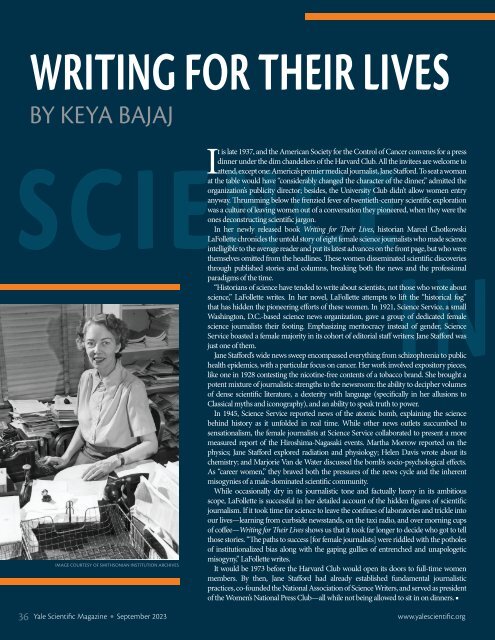YSM Issue 96.3
Create successful ePaper yourself
Turn your PDF publications into a flip-book with our unique Google optimized e-Paper software.
WRITING FOR THEIR LIVES<br />
BY KEYA BAJAJ<br />
SCIENCE<br />
IN<br />
IMAGE COURTESY OF SMITHSONIAN INSTITUTION ARCHIVES<br />
It is late 1937, and the American Society for the Control of Cancer convenes for a press<br />
dinner under the dim chandeliers of the Harvard Club. All the invitees are welcome to<br />
attend, except one: America’s premier medical journalist, Jane Stafford. To seat a woman<br />
at the table would have “considerably changed the character of the dinner,” admitted the<br />
organization’s publicity director; besides, the University Club didn’t allow women entry<br />
anyway. Thrumming below the frenzied fever of twentieth-century scientific exploration<br />
was a culture of leaving women out of a conversation they pioneered, when they were the<br />
ones deconstructing scientific jargon.<br />
In her newly released book Writing for Their Lives, historian Marcel Chotkowski<br />
LaFollette chronicles the untold story of eight female science journalists who made science<br />
intelligible to the average reader and put its latest advances on the front page, but who were<br />
themselves omitted from the headlines. These women disseminated scientific discoveries<br />
through published stories and columns, breaking both the news and the professional<br />
paradigms of the time.<br />
“Historians of science have tended to write about scientists, not those who wrote about<br />
science,” LaFollette writes. In her novel, LaFollette attempts to lift the “historical fog”<br />
that has hidden the pioneering efforts of these women. In 1921, Science Service, a small<br />
Washington, D.C.-based science news organization, gave a group of dedicated female<br />
science journalists their footing. Emphasizing meritocracy instead of gender, Science<br />
Service boasted a female majority in its cohort of editorial staff writers; Jane Stafford was<br />
just one of them.<br />
Jane Stafford’s wide news sweep encompassed everything from schizophrenia to public<br />
health epidemics, with a particular focus on cancer. Her work involved expository pieces,<br />
like one in 1928 contesting the nicotine-free contents of a tobacco brand. She brought a<br />
potent mixture of journalistic strengths to the newsroom: the ability to decipher volumes<br />
of dense scientific literature, a dexterity with language (specifically in her allusions to<br />
Classical myths and iconography), and an ability to speak truth to power.<br />
In 1945, Science Service reported news of the atomic bomb, explaining the science<br />
behind history as it unfolded in real time. While other news outlets succumbed to<br />
sensationalism, the female journalists at Science Service collaborated to present a more<br />
measured report of the Hiroshima-Nagasaki events. Martha Morrow reported on the<br />
physics; Jane Stafford explored radiation and physiology; Helen Davis wrote about its<br />
chemistry; and Marjorie Van de Water discussed the bomb’s socio-psychological effects.<br />
As “career women,” they braved both the pressures of the news cycle and the inherent<br />
misogynies of a male-dominated scientific community.<br />
While occasionally dry in its journalistic tone and factually heavy in its ambitious<br />
scope, LaFollette is successful in her detailed account of the hidden figures of scientific<br />
journalism. If it took time for science to leave the confines of laboratories and trickle into<br />
our lives—learning from curbside newsstands, on the taxi radio, and over morning cups<br />
of coffee—Writing for Their Lives shows us that it took far longer to decide who got to tell<br />
those stories. “The paths to success [for female journalists] were riddled with the potholes<br />
of institutionalized bias along with the gaping gullies of entrenched and unapologetic<br />
misogyny,” LaFollette writes.<br />
It would be 1973 before the Harvard Club would open its doors to full-time women<br />
members. By then, Jane Stafford had already established fundamental journalistic<br />
practices, co-founded the National Association of Science Writers, and served as president<br />
of the Women’s National Press Club—all while not being allowed to sit in on dinners. ■<br />
T<br />
S<br />
36 Yale Scientific Magazine September 2023 www.yalescientific.org

















